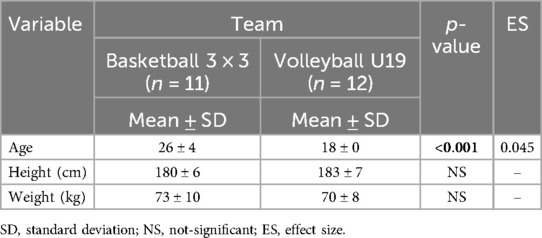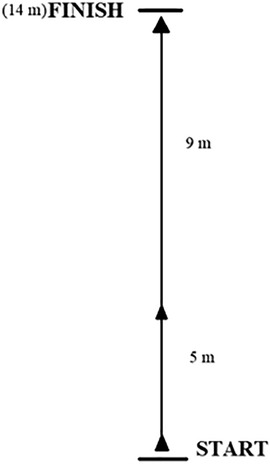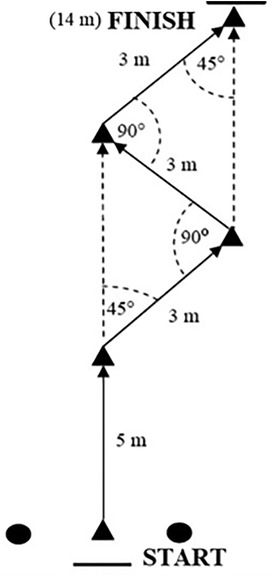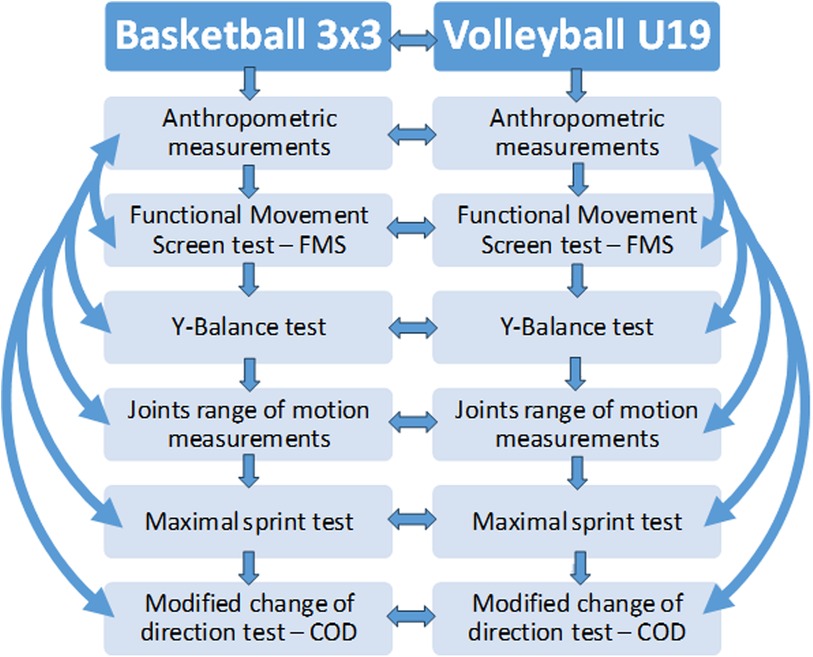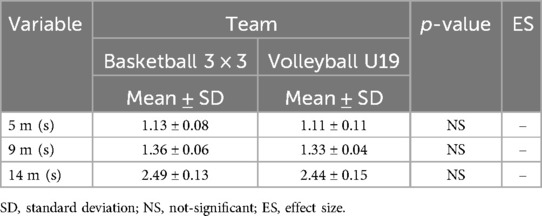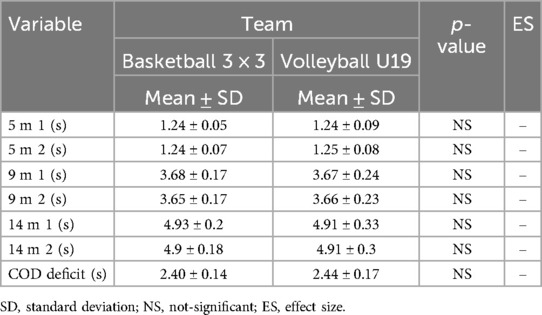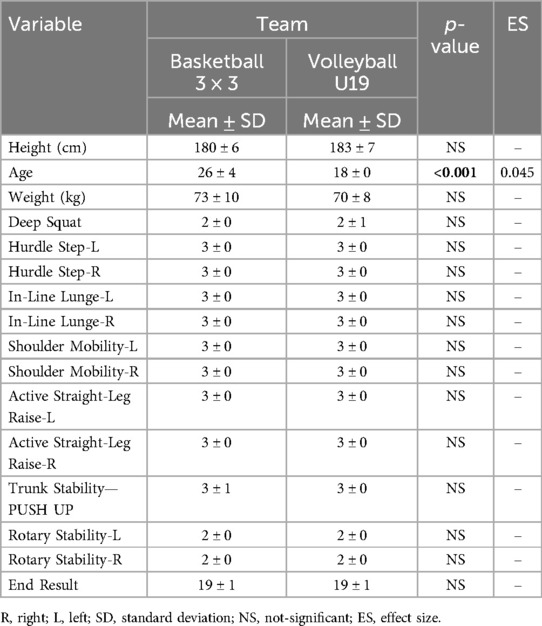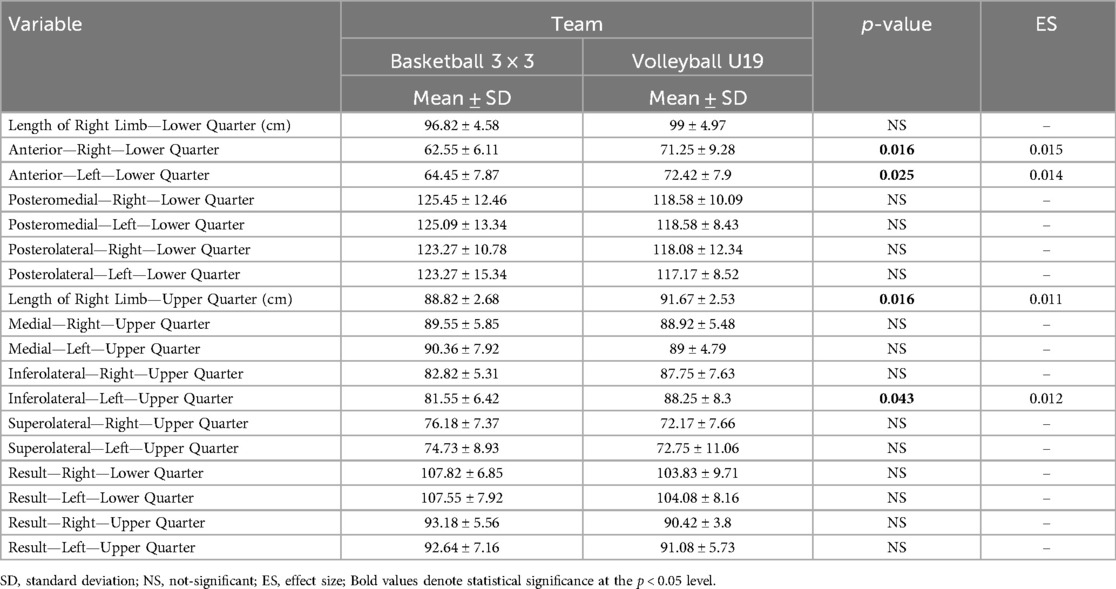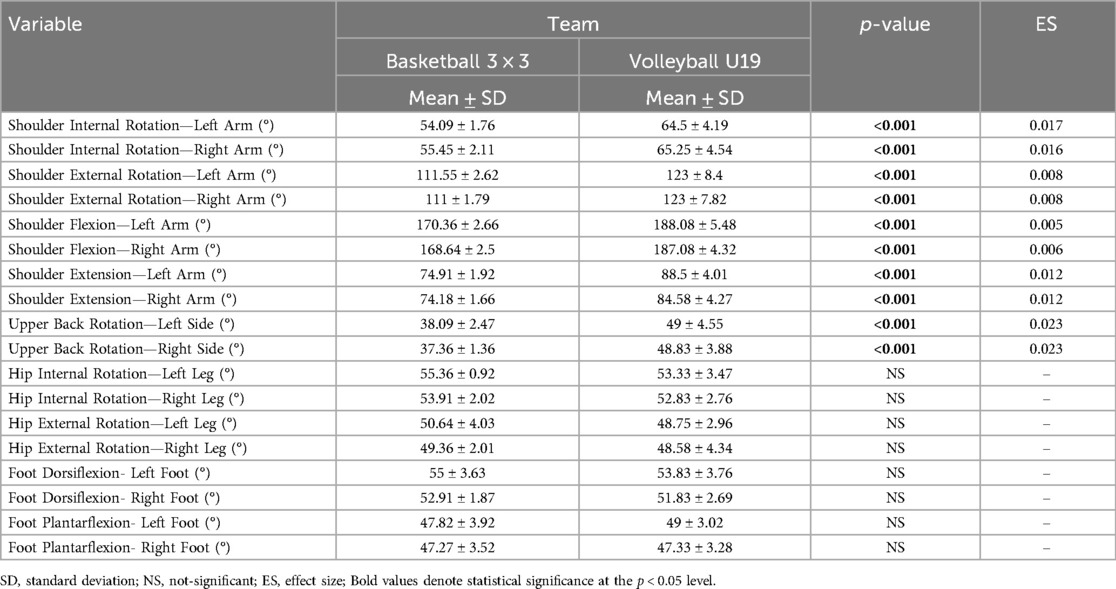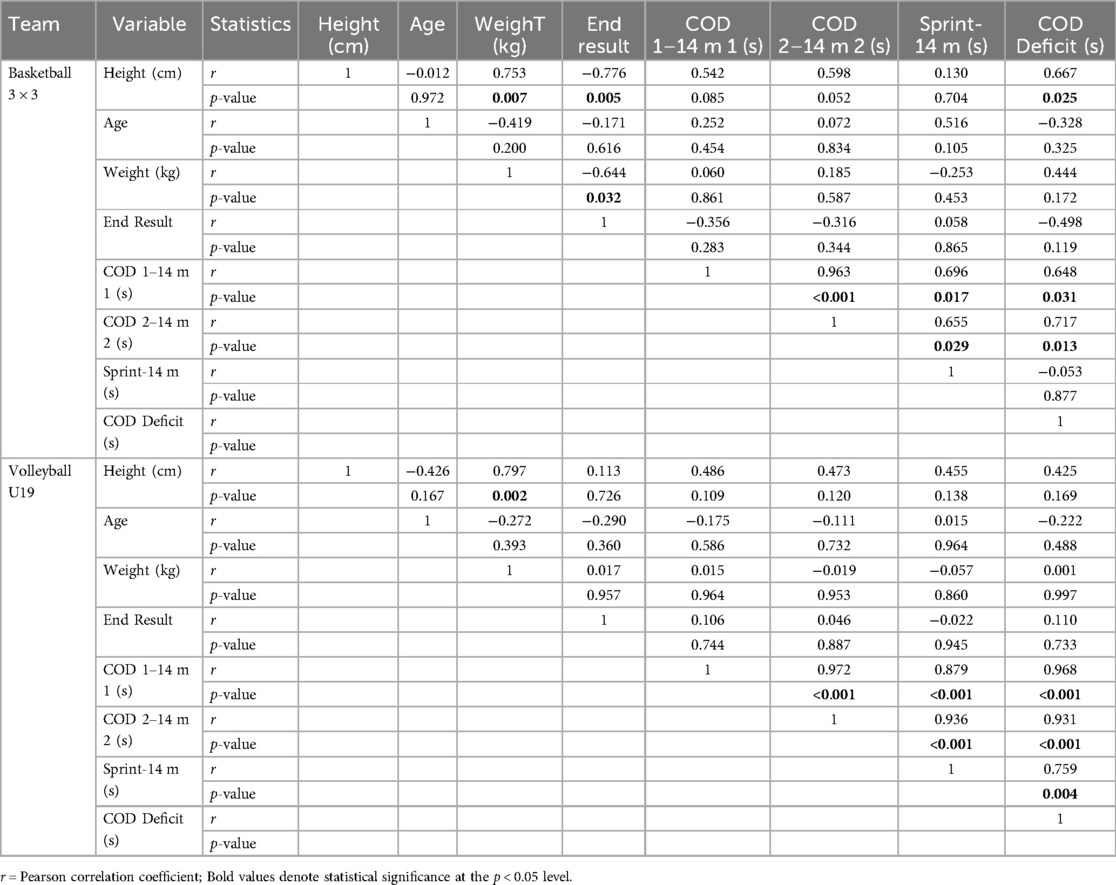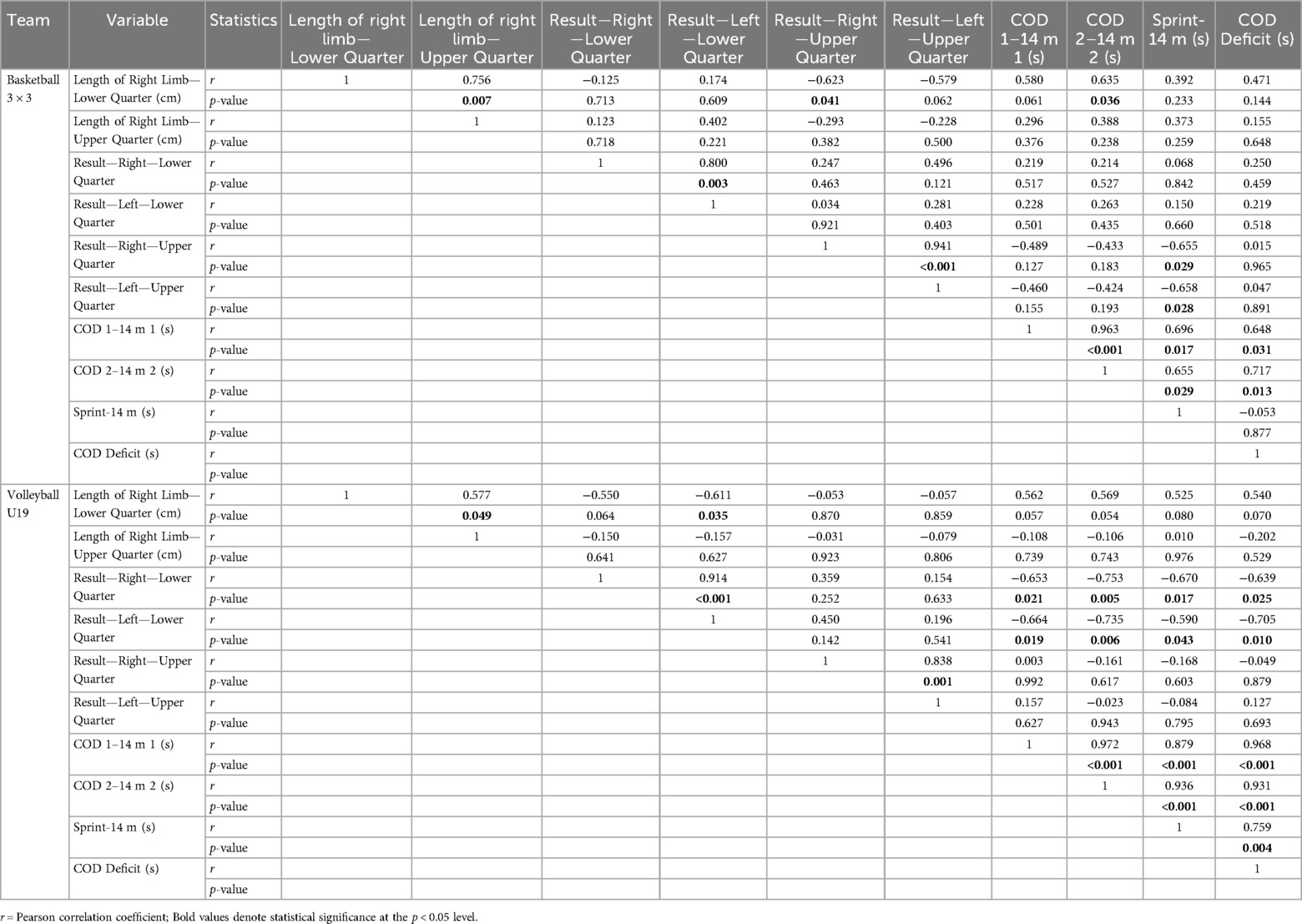- 1Department of Athletics, Middle Tennessee State University, Murfreesboro, TN, United States
- 2Department of Physical Education and Sport, Faculty of Pedagogy, University of West Bohemia, Pilsen, Czechia
- 3Department of Biostatistics and Medical Informatics, Faculty of Medicine, Inonu University, Malatya, Türkiye
The purpose of this study was to determine the extent of differences in the level of change in linear speed and velocity in the modified change of direction test (COD) and to determine the relationship between speed deficits resulting from changes of direction and functional performance between groups of Polish U19 Volleyball National Team and Polish Women's Basketball 3 × 3 National Team. A total of 23 athletes: 12 volleyball players (age: 18 ± 0 years; body height: 183 ± 7 cm; body weight: 70 ± 8 kg) and 11 basketball players (age: 26 ± 4 years; body height: 180 ± 6 cm; body weight: 73 ± 10 kg) participated in the study. Athletes were tested for the following measures: Functional Movement Screen test (FMS), dynamic balance test Y-Balance, joints range of motion measurements, maximal sprint test (14 m), modified COD test (14 m) and change of direction deficit (CODD). A value of p < 0.05 was considered statistically significant. There was no significant correlation between sprint and CODD results in basketball team. In volleyball team there was a positive and significant correlation between COD, sprint and CODD. There was a negative and significant correlation between Y-Balance scores and sprint test results in the basketball team. Basketball team had a positive significant correlation between hip rotations and COD results. There was a negative significant correlation between shoulder movements and COD and CODD results in volleyball team.
Introduction
In numerous team sports, the movement of the player is based on rapid changes of direction (COD) combined with frequently repeated sprints (1, 2). Changes in direction of movement are conditioned by the actions of the opponent, the tactics of the team or the current sports result. Factors affecting the timing of directional changes are the speed of the run-up, the angle of directional change, and the power generated during running (3). In addition, COD time is influenced by the orientation of the body position determined by the direction in which the lower limbs and hip are pointed during movement (4). Especially in impact sports, such as volleyball, this direction is often determined by the position of the opponent relative to the net. Spiteri et al. (4) and Suchomel et al. (3) emphasize the importance of leg muscle strength for fast COD. In addition, somatic build and age of athletes appear to influence COD performance (4, 5). The speed of moving with changes in direction and the speed of sprinting are determined by the generation of force relative to the ground and the shortest possible ground contact time during each step (3). However, unlike sprinting, in team games, directional changes occur in different planes, at different angles, transitioning from forward movements to lateral or backward movements (1, 2). Depending on the specific sport and position, some COD patterns occur more frequently than others (4, 5). Athletes with a high ability to change direction have an advantage in offensive and defensive situations (4). Successful changes of direction that are unpredictable to the opponent determine victory in team games. This is crucial, particularly in the context of team sports, because in team sports, change of direction is the foremost requirement for players (6).
The literature on the relationship between age and COD performance is very limited. In the work of Loturco et al. (45) an analysis of the speed in the COD test of soccer players aged U15, U17, U20, and Senior was performed. The authors note that the COD result is undoubtedly influenced by the level of dynamic force—power, which is related to the need to accelerate multiple times over a short distance (7). The biological development supporting this motor characteristic in women ends before the age of 18 (7). Therefore, this factor did not differentiate our subjects. Of course, there remains the issue of training experience, which in the case of the senior 3 × 3 basketball team examined was longer than in the case of the junior volleyball team. However, taking into account that senior teams include players aged 18 to 35, maintaining the division into age groups would not be possible to standardize senior teams in terms of test results. An additional argument for the possibility of comparing both groups was the fact that the players of both teams played in league matches in their sports disciplines at the same level of competition (first league). Therefore, the biological factor equally supported the process of improving running power, and the athletes represented the same sports level adequate to their disciplines (8).
Volleyball is a sport in which players must react in a dynamically changing and unpredictable environment (9). During the game, players constantly adjust their movements to temporal and spatial assumptions, and consequently develop eye-controlled motor coordination mechanisms. Reactive maneuvers in this sport require the integration of functional fitness with motor components (10). In volleyball, 83.7% of actions last less than 10 s, with men's actions being shorter than women's. The distances covered, are 85.3% less than 15 meters including 45.7% between 5 and 10 meters (11). Therefore, sprint and COD tests should be tailored to volleyball-specific requirements (12). Volleyball players mainly cover short distances, and lateral movements often occur after only a few steps of forward running.
3 × 3 basketball is a sport that features a high intensity workload in a relatively short period of time. One game lasts 15 to 20 min, and each player has his individual average time, which he spends either playing or sitting on the bench. Consider that the number of measured directional changes in 3 × 3 basketball is much higher than in the classic variety of this sport, as it consists of more lateral and backward movements. Montgomery and Maloney (46) analyzed data from elite 3 × 3 games and found that elite players made 32 accelerations, 34 decelerations and 11 directional changes during a single court entry. The facts highlighted earlier indicate that COD speed is one of the most important determinants of success in basketball (13).
The relationship between functional abilities and performance indicators remains unclear. An investigation into whether functional status scores are related to tests of speed (sprint) and changes of direction (COD) is warranted to verify these ambiguities. Evidence on whether specific scores on the Functional Movement Screening test (FMS), Y-Balance test or joints range of motion measurements have associations with athletic performance is limited (14, 15). Despite research in this area, the relationship between functional fitness and speed and change of direction profiles has not been fully elucidated (14, 15). Evidence is lacking regarding the relationship between functional testing and kinematic performance: linear speed (sprint), COD ability, change of direction deficit (CODD) in elite athletes.
A limited number of studies have examined the relationship between linear sprinting and COD deficits in groups of team sport athletes (16–18). Freitas et al. (8) showed using a comparison of players’ acceleration magnitudes that players who accelerated faster produced a higher COD deficit. Additionally, Loturco et al. (16) pointed to the implementation of special training programs that would emphasize replicating situations similar to those in real games, which also, have a positive impact on reducing the COD deficit (5, 19, 20).
The work of Hernández-Davó et al. and Gonzalo-Skok et al. highlighted the relationship of the ability to change direction with a small loss of speed to functional status.
Research from Opplert et al. on the impact of muscle mobility on the performance of athletes showed that there is strong evidence confirming the positive or neutral effect of dynamic stretching on muscle performance (21).
The study undertaken was to determine the extent of differences in the level of change in linear speed and velocity in the modified COD test between groups of Polish U19 Volleyball National Team and Polish Women's Basketball 3 × 3 National Team. The second objective was to determine the relationship between speed deficits resulting from changes of direction and functional performance in female national team level volleyball and 3 × 3 basketball athletes.
The hypotheses of the study were that it will be a correlation between the functional status as assessed by the FMS test, Y-Balance test and joints range of motion measurements and the change of direction (COD) ability, change of direction deficit (COD deficit) and linear speed (sprint) in elite 3 × 3 basketball and volleyball players (U19). And there will also be differences in the level of change in linear speed and velocity in the modified COD test between groups of Polish U19 Volleyball National Team and Polish Women's Basketball 3 × 3 National Team.
Materials and methods
Experimental approach to the problem
A cross-sectional design was performed in this study to estimate the relationship between chosen variables related to COD and CODD. First part of the study included functional assessment. At the second part subjects performed a maximum running test over a distance of 14 meters and a change of direction test—CODAT, in modification of the purpose of the study, also over a distance of 14 meters. The activities were to examine:
– Differences in the level of change in linear speed and speed in the modified COD test between groups of volleyball (U19) and basketball 3 × 3 players at the level of the Polish National Team,
– Relationships between speed deficits resulting from changes of direction and functional status in female national team members in volleyball (U19) and 3 × 3 basketball.
Subjects
The study included 23 female members of Polish National Team in volleyball (U19) and basketball 3 × 3. The characteristics of the study groups are shown in Table 1. Before taking part in the study, each participant was informed of the purpose of the study and the confidentiality of the results. Participants were free to withdraw their participation in the study without any consequences. The study was approved by the institutional bioethics committee of the Jan Długosz University in Częstochowa (KE-U/2/2021) and the subjects were informed of the benefits and risks of the investigation prior to signing an institutionally approved informed consent document to participate in the study. Additionally, for every subject who was under the age of 18 years old, parental or guardian signed consent was obtained. Inclusion criteria were: consent to participate in the study, good health and active participation in a regular training regimen. Exclusion criteria were: lack of permission from the coach, injury or illness, and rehabilitation that did not allow the participant to take part in regular training. The study was conducted during a normal training week. Twenty-four hours before the study, the athletes did not perform any physical exertion, did not use ergogenic agents and did not take caffeine-containing preparations.
Procedures
The procedures were carried out in March of 2022, during the regular season for both teams. The study was conducted in two parts. The first part of the study: assessment of functional status, based on tests: FMS, Y-Balance and joints range of motion measurements. All measurements were carried out from 8 a.m. to 12 p.m., keeping the order of subjects constant. The second part of the study: sprint (14 m) and modified COD (14 m) tests, were conducted the following day from 8:00 a.m. to 12:00 p.m., keeping the same order of subjects. Throughout all the tests, players were instructed to perform their maximum effort and were verbally encouraged by the research team. The standardized warm-up in all testing sessions consisted of dynamic warm-up progressing from general to sport-specific movement patterns to prepare the athletes for activity. General movements during the warm-up aimed to activate total body musculature in the different planes of motion (e.g., lunge and twist, reverse lunge and overhead reach, world's greatest stretch, lateral lunges, inchworms, knee hugs, ankle pulls, and side sweeps). Sport-specific activities included the carioca, high knees, skips for maximal height and distance, and drills involving accelerations, decelerations, and COD actions (such as a sprint, side shuffle right, backpedal, side shuffle left, and sprint to the end line). Following the dynamic warm-up, the team would transition into two submaximal sprints over 14 m, and two maximal sprints over the same distance.
In all experiments, exclusion criteria were as follows: (a) potential medical problems or an injury history of ankle, knee, or back pathology in the last three months prior to the study; (b) previous medical, drug or orthopaedic problems that compromised their participation or performance in this study.
In all experiments, participants were instructed to maintain their daily habits (e.g., exercise, nutrition) for the whole duration of the study. In all experiments, before signing an informed consent document, all the participants were carefully informed about the experiment procedures, the potential risk and benefits associated with participation in the study.
Anthropometric measurements
All anthropometric measurements were taken according to standard methods: body height (to the nearest 0.1 cm), body weight (0.1 kg). Participants wore light indoor clothing and were barefoot when measured. Measurements were taken using a METRISIS anthropometer and a TANITA MC-780 P MA scale.
Functional movement screen test—FMS
The FMS concept provides a simple, accessible and quantifiable way to assess the quality of movement patterns and identify any limitations or asymmetries in subjects. The FMS consists of 7 basic items, during which disorders in a given kinematic chain are highlighted (22). These tests assess joint mobility, muscle flexibility, stability, coordination and balance skills (23). Individuals who have difficulty performing the tests may develop compensatory patterns during motor activity that limit maximum physical capabilities, leading to biomechanical movement disorders with consequent injury.
The FMS assessment was performed without a warm-up, and athletes wore athletic attire and footwear. Specialized equipment was used to conduct the test: “KITM” (manufacturer: Technomex). The kit included a base: plank with dimensions of 5, 15, 150 cm, tubes with centimeter scale and rubber cord (24).
Y-Balance test
The Y-Balance test is performed by dividing the body into four parts (lower quarter-right side, lower quarter-left side, upper quarter-right side, upper quarter-left side) and for functional diagnosis of the spine and each limb under the influence of body weight (25, 26). The device and protocol are highly accurate and can be used to measure dynamic balance for physically active individuals (27). The Y-Balance dynamic balance test consists of two components:
– lower body,
– upper body.
The test subject performs 3 tests in each of the 3 directions, for each part (lower and upper) and for each limb (right and left), and the maximum reach in each direction is used for analysis. The composite score of the test, the sum of the maximum reach in each of the three directions of the reach divided by three times the length of the limb, and then multiplied by 100. It gives a picture of the overall performance of the test subject and refers to his body (27).
The Y-Balance dynamic assessment was performed without a warm-up, and athletes wore athletic attire and footwear. Specialized equipment was used to conduct the test: “KIT” (manufacturer: Technomex).
Joints range of motion measurements
The basis of this part of the diagnostic was a thorough examination of the ranges of motion in individual joints, in order to obtain basic information about the athlete's skeletal system and posture (28). The goal was to gain information that would identify limitations, dysfunctions and asymmetries in the athlete's posture and movement. These limitations can negatively affect athletic performance and exercise quality and significantly increase the risk of injury or trauma (29, 30).
The most important joints and muscles were analyzed, whose dysfunction can affect the subjects’ performance, economy of movement, and increase the risk of injury.
The diagnostics consist of 18 measurements that provide a picture of an athlete's biomechanics and allow us to effectively help improve the athlete's body:
– shoulder internal rotation: left and right arm,
– shoulder external rotation: left and right arm,
– shoulder flexion: left and right arm,
– shoulder extension: left and right arm,
– upper back rotation: left and right side,
– hip internal rotation: left and right leg,
– hip external rotation: left and right leg,
– foot dorsiflexion: left and right foot,
– foot plantarflexion left and right foot.
Joints range of motion measurements were taken without a warm-up, and athletes wore athletic attire. The Gyko inertial sensor (manufacturer: Microgate), which has been introduced in sports science (31, 32), was used for the assessment. Before the measurements began, the device was mounted in a safety band and placed around the measured test segment, depending on the movement that was to be tested. The range of motion module was used for the test. All measurements of joint range of motion angles were given in degrees.
Maximal sprint test
The performance of the speed effort was preceded by a standard 20 min warm-up. The subjects performed a 14-meter sprint from a standing position 3 times. Timing gates were placed at the beginning, 5th and 14th meters of the distance. Time was recorded using the SmartSpeed Pro Timing Gates system (Fusion Sport, USA). Timing results were done at the 5 m and 14 m distances. No instructions were given on the most efficient movement technique, and the subjects were instructed to run the distance as fast as possible. Linear speed analysis typically involves recording data over multiple trials. Accurate data collection requires consistency across these trials (33). So, 3 trials of each sprint were performed, after which the best result was selected for analysis (28). The dimensions of the test are shown in Figure 1.
Modified change of direction test—COD
The change of direction (COD) test was designed based on research analyzing movement over time in team sports. It assesses the ability to change direction while sprinting forward. The study used a modification of the standard COD test. The modifications consisted of removing a 10-meter section covered in a straight line in the final part of the test. The modified change of direction test performed by the subjects included a 5-meter sprint in a straight line, followed by three 3-meter sprints performed at 45° and 90°. The dimensions and direction of movement for the COD are shown in Figure 2.
Performance of the test was preceded by a standard 20 min warm-up. Time was recorded using the SmartSpeed Pro Timing Gates system (Fusion Sport, USA). Timing results were done at 5 m and 14 m distances. No instructions were given on the most effective movement technique, and subjects were instructed to complete the test as quickly as possible (34).
Analysis of linear velocity and rate of change of direction usually involves recording data over multiple trials. Accurate data collection requires consistency across these trials (33). So, 2 sets were performed, with 5 repetitions of the test in each, where a 30 s rest was used between repetitions, and 6 min of rest were taken after the entire set.
All of the measurement's methods and their relations between each other was presented in Figure 3.
Statistical analyses
The conformity of the variables to the normal distribution was examined by visual (histogram and probability graphs) and analytical (Shapiro-Wilk Test) methods. The assumption of homogeneity of variances was examined with the Levene test. Descriptive statistics were expressed as mean ± standard deviation as quantitative data were normally distributed. Independent samples t-test was used to examine whether there was a significant difference between the teams in terms of FMS, Y-balance, joints range of motion measurements, sprint and COD test results. The effect size was calculated using Cohen's D. The size of the effect size was assessed by following the thresholds: Cohen considers d = 0.2 to be a “small” effect size, 0.5 represents a “moderate” effect size and 0.8 represents a “large” effect suggested that he did (35). Dimension. Relationships between results were made using the Pearson-r product moment correlation test. The size of the correlations was defined as: <0.1 = insignificant, 0.1–0.3 = small, 0.3–0.5 = moderate, 0.5–0.7 = large, 0.7–0.9 = very large and >0.9 = almost perfect (36). A value of p < 0.05 was considered statistically significant. Statistical differences were reported using the American Psychological Association (APA) 6.0 style. Analyzes were performed using the SPSS 28.0 (IBM Corp., Armonk, NY, USA) package program.
Results
There was no significant difference between the basketball 3 × 3 and volleyball teams in terms of the results of the sprint test (p > 0.05) (Table 2).
There was no statistically significant difference between the teams in the COD test results (p > 0.05) (Table 3).
The results of the age, body height, body weight and FMS test of the participants are presented in Table 4. There was no statistically significant difference between the teams in FMS test results (p > 0.05).
The changes of the results of the Y-Balance test according to the teams are as in Table 5. Volleyball anterior-right—lower quarter, anterior-left—lower quarter, length of right limb—upper quarter and inferolateral-left—upper quarter results were significantly higher than the basketball 3 × 3 team (p < 0.05).
The changes in the joints range of motion measurements in the teams were given in Table 6. The effect of the teams was important in all of the upper body measurements (p < 0.05). Results showed that the results of the joints range of motion measurements in volleyball team were higher than the basketball 3 × 3 team.
The basketball 3 × 3 team showed a negative and significant correlation between body height and the end result of the FMS test, but there was a positive correlation between the body height and the COD deficit result. COD 14 m results with sprint 14 m, and COD deficit results were found to be a positive correlation between the results. However, there was no significant correlation between sprint 14 m and COD deficit results in the basketball 3 × 3 team. In volleyball team there was a positive and significant correlation between COD 14 m, sprint 14 m and COD deficit (Table 7).
In the basketball 3 × 3 team there was a positive significant correlation between length of right limb—lower quarter and length of right limb—upper quarter. There was a negative correlation between length of right limb—lower quarter results and result—right—upper quarter results between the results of the basketball 3 × 3. There was a negative and significant correlation between result—right—upper quarter and result—left—upper quarter results and sprint 14 m results. In the volleyball team, there was a positive correlation between length of right limb—lower quarter and length of right limb—upper quarter, while the length of right limb—lower quarter and result—left—lower quarter had a significant correlation between the high level. In addition, there was a negative significant correlation between result—right—lower quarter and result—left—lower quarter results and COD 14 m 1, sprint 14 m and COD deficit results (Table 8).
Basketball 3 × 3 team had a positive significant correlation between hip internal rotation—right leg and COD 14 m results. Therefore, as the results of hip internal rotation—right leg increased, COD 14 m results increased. The results of the upper back rotation—left side and sprint 14 m test results were found to have a negative significant correlation. Therefore, when the results of the upper back rotation left side increased, sprint 14 m results decreased. However, there was no significant correlation between joints range of motion measurements: rotations results and sprint and COD tests in volleyball team. The results of the upper back rotation—left side and sprint 14 m test results were found to have a negative significant correlation (Table 9).
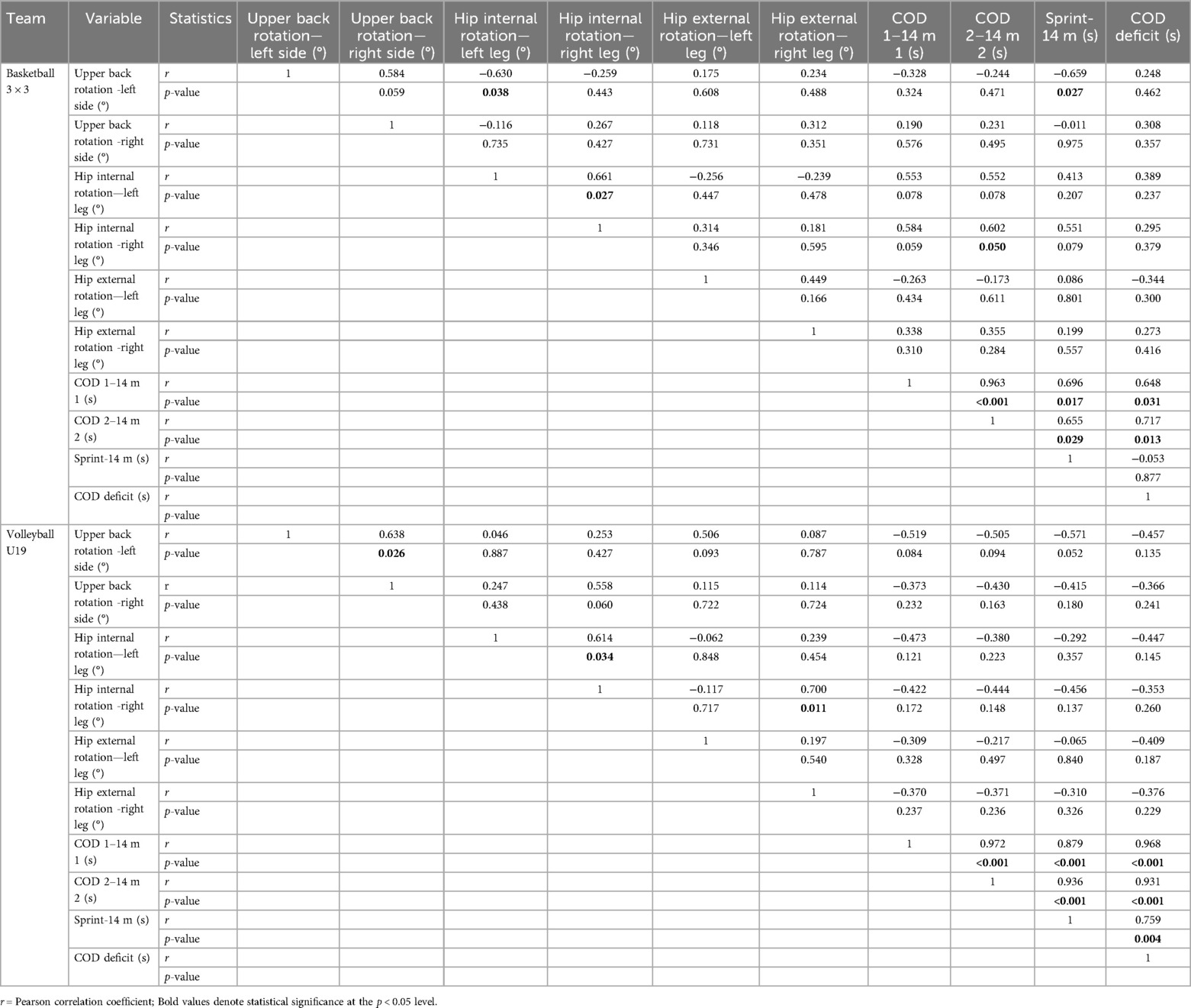
Table 9. Results of correlation analysis between joints range of motion measurements: rotations, sprint and COD test in teams.
The basketball 3 × 3 team had a negative significant correlation between shoulder extension and COD deficit results, and therefore the results of the COD deficit decreased when the results of the shoulder extension—left arm increased. There was a negative significant correlation between shoulder extension—left arm and COD 14 m and COD deficit results, but there was no significant correlation between the results of shoulder extension—left arm and sprint 14 m. In the volleyball team there was very large significant positive correlation between the sprint 14 m test and COD deficit results, but there was no significant correlation between the results of shoulder movements, COD and sprint 14 m tests (Table 10).
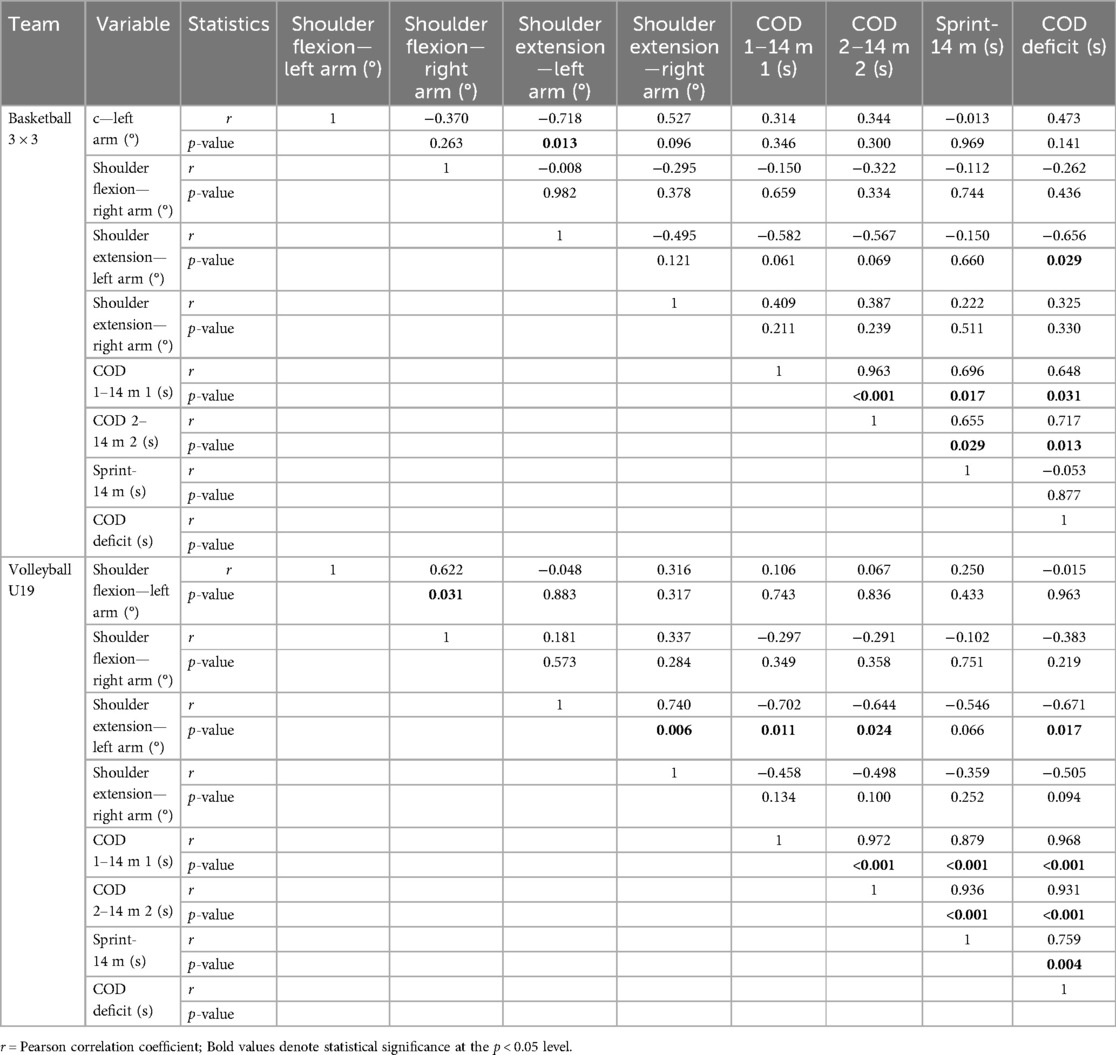
Table 10. Results of correlation analysis between joints range of motion measurements: shoulder movements, sprint and COD tests in teams.
Discussion
In team sports, players with a high ability to change direction gain an advantage in field situations (4, 37). It can determine victory in team games, so sprints and directional change tasks are a very important factor in training and physical preparation diagnostics (4, 5). Improving the efficiency of an athlete's movement on the field can be conditioned to a large extent by the level of functional status and the level of physical preparation in terms of generate power (3–5).
According to the real-life scenario of 3 × 3 basketball and volleyball, the majority of directional change maneuvers take place at angles between 0 and 90° (38, 39). This condition is met by the COD test, which was used in a study of female athletes in these two sports.
A study by Sayers (47) found that COD should be measured at shorter distances to avoid the influence of linear velocity. Therefore, the study modified the COD test by reducing it from 24 meters to a distance of 14 meters. The results obtained were related to the sprint test over a distance of 14 meters. The COD values of the deficit, which is the difference between the time results from the COD 14 m test and the time results from the sprint 14 m test, were obtained, which corresponds to the specifics of both sports.
There was no significant difference in the timing results between the 3 × 3 basketball and volleyball teams in the sprint, COD and COD deficit tests.
In 3 × 3 basketball and volleyball teams, a positive and statistically significant correlation was found between COD, sprint and deficit COD scores. These results apply to all distances and are consistent with previous studies (37, 38).
A limited number of studies have examined the relationship between linear sprinting and COD deficits in groups of team sport athletes (16–18). Our results are consistent with the findings of Papli et al. (18), where the authors showed that 20 m linear sprint time was not significantly correlated with COD deficit in two different tests. This observation is consistent with previous studies in team sports, in which participants were rugby (40, 41), soccer (8, 16) and handball players (42). More specifically, Loturco et al. (16) on a sample of 25 male soccer players, after dividing them into groups of faster and slower players, found that the faster players had higher COD deficit values. Freitas et al. (8) showed using a comparison of players’ acceleration magnitudes that players who accelerated faster produced a higher COD deficit.
Thus, we can conclude that the transition from linear speed to COD is a common problem in team sports (2). To this end, Loturco et al. (16) pointed to the implementation of special training programs that would emphasize replicating situations similar to those in real games, which also, have a positive impact on reducing the COD deficit, stressing that the athlete must exert significant forces on the ground, both horizontally and vertically, in the shortest possible time in order to continuously and efficiently perform accelerations and decelerations (5, 19, 20).
The work of Hernández-Davó et al. and Gonzalo-Skok et al. highlighted the relationship of the ability to change direction with a small loss of speed to functional status. Female athletes of the Polish National Team in volleyball (U19) and basketball 3 × 3 had high FMS scores. There was no significant difference between the teams in both the final scores and the final scores for the right and left sides.
Comparing the Y-Balance tests, we note that the volleyball team's measurements on the lower quarter-right side, lower quarter-left side, upper quarter-right side, upper quarter-left side were significantly higher than those of the 3 × 3 basketball team. Grassi et al. indicated that the Y-Balance test requires lower limb muscle strength, coordination and agility (43). These are qualities that also determine the ability to change direction quickly. Joints range of motion measurements showed that all upper-body outcomes in the volleyball team were higher than the 3 × 3 basketball team. Sport-specific adaptations in joints range of motion may occur in athletes, such as volleyball players, due to the narrow specialization of the sport practiced and the very high frequency of performing specific ranges of motion (44). Therefore, our study confirms these relationships.
However, in the work by Opplert et al. on the impact of muscle mobility on the performance of athletes, they showed that there is strong evidence confirming the positive or neutral effect of dynamic stretching on muscle performance (21).
Therefore, compared to other works, the findings in our study regarding the relation between functional ability and joint mobility and sprinting, COD and COD deficit seem to be very interesting.
From the practical application's standpoint of our analysis, each athlete's functional and movement deficits should be taken into account in order to program an appropriately individualized process to improve movement and change of direction performance.
Surprisingly, no range of differences were recorded in the level of change in linear speed and modified COD test results between the groups of volleyball and 3 × 3 basketball players.
However, linear sprint tests and change of direction (COD) tests with specific distance assessment (5, 9, 14 m) seem to be reliable tools recommended in the training process for both 3 × 3 basketball and volleyball.
We would also like to show areas that our research does not explain, and our results cannot be taken into account when making decisions regarding other than a specific sports level in the two sports we describe. The volleyball and basketball 3 × 3 players presented in our study, represent an elite level, so our analysis cannot be transposed to younger teams or teams at a basic level of their sport.
Conclusions
In conclusion, there was a correlation between the functional status as assessed by the FMS test, Y-Balance test and joints range of motion measurements and the change of direction (COD) ability, change of direction deficit (COD deficit) and linear speed (sprint) in elite 3 × 3 basketball and volleyball players (U19).
Our analysis can provide future research directions in correlation with the relevant results of the study about the complexity of COD and COD deficit performance. Which will allow practitioners to make more specific decisions about its formation during the training process. Because traditional training processes may not be applicable to COD ability development. Instead of linear sprinting drills, more functional ability-based protocols, oriented to the specifics of basketball and volleyball and targeted to specific tasks in a given sport, should be used.
Data availability statement
The original contributions presented in the study are included in the article/Supplementary Material, further inquiries can be directed to the corresponding author.
Ethics statement
Written informed consent was obtained from the individual(s), and minor(s)' legal guardian/next of kin, for the publication of any potentially identifiable images or data included in this article.
Author contributions
ZC: Conceptualization, Data curation, Formal Analysis, Investigation, Methodology, Project administration, Validation, Writing – original draft, Writing – review & editing. TG: Conceptualization, Investigation, Methodology, Project administration, Resources, Supervision, Validation, Writing – original draft, Writing – review & editing. FY: Data curation, Formal Analysis, Software, Writing – original draft, Writing – review & editing. LC: Funding acquisition, Investigation, Supervision, Validation, Writing – original draft, Writing – review & editing.
Funding
The author(s) declare that no financial support was received for the research, authorship, and/or publication of this article.
Acknowledgments
The authors express their sincere gratitude to all subjects in the present study.
Conflict of interest
The authors declare that the research was conducted in the absence of any commercial or financial relationships that could be construed as a potential conflict of interest.
Publisher's note
All claims expressed in this article are solely those of the authors and do not necessarily represent those of their affiliated organizations, or those of the publisher, the editors and the reviewers. Any product that may be evaluated in this article, or claim that may be made by its manufacturer, is not guaranteed or endorsed by the publisher.
References
1. Little T, Williams AG. Specificity of acceleration, maximum speed, and agility in professional soccer players. J Strength Cond Res. (2005) 19(1):76. doi: 10.1519/14253.1
2. Salaj S, Markovic G. Specificity of jumping, sprinting, and quick change of direction motor abilities. J Strength Cond Res. (2011) 25(5):1249–55. doi: 10.1519/JSC.0b013e3181da77df
3. Suchomel TJ, Nimphius S, Stone MH. The importance of muscular strength in athletic performance. Sports Med. (2016) 46(10):1419–49. doi: 10.1007/s40279-016-0486-0
4. Spiteri T, Newton RU, Binetti M, Hart NH, Sheppard JM, Nimphius S. Mechanical determinants of faster change of direction and agility performance in female basketball athletes. J Strength Cond Res. (2015) 29(8):2205–14. doi: 10.1519/JSC.0000000000000876
5. Dos'Santos T, Thomas C, Jones PA, Comfort P. Mechanical determinants of faster change of direction speed performance in male athletes. J Strength Cond Res. (2017) 31(3):696–705. doi: 10.1519/JSC.0000000000001535
6. Fasold F, Braun A, Klatt S. Effects of arm dominance and decision demands on change of direction performance in handball players. J Hum Kinet. (2023) 85:127–35. doi: 10.2478/hukin-2022-0116
8. Freitas TT, Pereira LA, Alcaraz PE, Arruda AFS, Guerriero A, Azevedo PHSM, et al. Influence of strength and power capacity on change of direction speed and deficit in elite team-sport athletes. J Hum Kinet. (2019) 68(1):167–76. doi: 10.2478/hukin-2019-0069
9. Araújo D, Davids K, Hristovski R. The ecological dynamics of decision making in sport. Psychol Sport Exerc. (2006) 7(6):653–67. doi: 10.1016/j.psychsport.2006.07.002
10. Farrow D, Abernethy B. Do expertise and the degree of perception-action coupling affect natural anticipatory performance? Perception. (2003) 32(9):1127–39. doi: 10.1068/p3323
11. Hank M, Malý T, Zahálka F, Dragijsky M, Bujnovsky D. Evaluation of the horizontal movement distance of elite female beach volleyball players during an official match. Int J Perform Anal Sport. (2016) 16(3):1087–101. doi: 10.1080/24748668.2016.11868950
12. Melrose DR, Spaniol FJ, Bohling ME, Bonnette RA. Physiological and performance characteristics of adolescent club volleyball players. J Strength Cond Res. (2007) 21(2):481. doi: 10.1519/R-19185.1
13. Stojanović E, Aksović N, Stojiljković N, Stanković R, Scanlan AT, Milanović Z. Reliability, usefulness, and factorial validity of change-of-direction speed tests in adolescent basketball players. J Strength Cond Res. (2019) 33(11):3162–73. doi: 10.1519/JSC.0000000000002666
14. Hrysomallis C. Balance ability and athletic performance. Sports Med. (2011) 41:221–32. doi: 10.2165/11538560-000000000-00000
15. Marchetti PH, Orselli MI, Duarte M. The effects of uni- and bilateral fatigue on postural and power tasks. J Appl Biomech. (2013) 29:44–8. doi: 10.1123/jab.29.1.44
16. Loturco I, Nimphius S, Kobal R, Bottino A, Zanetti V, Pereira L, et al. Change of direction deficit in elite young players: the limited relationship between conventional speed and power measures and change of direction performance. Ger J Exerc Sport Res. (2018) 48:228–34. doi: 10.1007/s12662-018-0502-7
17. Loturco I, Pereira LA, Reis VP, Abad CCC, Freitas TT, Azevedo PHSM, et al. Change of direction performance in elite players from different team sports. J Strength Cond Res. (2022) 36(3):862–6. doi: 10.1519/JSC.0000000000003502
18. Papla M, Krzysztofik M, Wojdala G, Roczniok R, Oslizlo M, Golas A. Relationship between linear sprint, lower body power output and change of direction performance in elite soccer players. Int J Environ Res Public Health. (2020) 17:6196. doi: 10.3390/ijerph17176119
19. Condello G, Kernozek TW, Tessitore A, Foster C. Biomechanical analysis of a change of direction task in college soccer players. Int J Sports Physiol Perform. (2016) 11(1):96–101. doi: 10.1123/ijspp.2014-0458
20. Havens KL, Sigward SM. Whole body mechanics differ among running and cutting maneuvers in skilled athletes. Gait Posture. (2015) 42(3):240–5. doi: 10.1016/j.gaitpost.2014.07.022
21. Opplert J, Babault N. Acute effects of dynamic stretching on muscle flexibility and performance: an analysis of the current literature. Sports Med. (2018) 48(2):299–325. doi: 10.1007/s40279-017-0797-9
22. Cook G, Burton L, Hoogenboom B. Pre-participation screening: the use of fundamental movements as an assessment of function- part 1. N Am J Sports Phys Ther. (2006) 1(2):5–6.
23. Kiesel K, Plisky PJ, Voight ML. Can serious injury in professional football be predicted by a preseason functional movement screen? N Am J Sports Phys Ther. (2007) 2(3):3–4. doi: 10.1519/14253.1
24. Teyhen DS, Shaffer SW, Lorenson CL, Halfpap JP, Donofry DF, Walker MJ, et al. The functional movement screen: a reliability study. J Orthop Sports Phys Ther. (2012) 42(6):4–5. doi: 10.2519/jospt.2012.3838
25. Garrison JC, Bothwell JM, Wolf G, Aryal S, Thigpen CA. Y-Balance test anterior reach symmetry at three months is related to single leg functional performance at time of return to sports following anterior cruciate ligament reconstruction. Int J Sports Phys Ther. (2015) 10(5):602–11. doi: 10.1519/JSC.0000000000003502
26. Shaffer SW, Teyhen DS, Lorenson CL, Warren RL, Koreerat CM, Straseske CA, et al. Y balance test: a reliability study involving multiple raters. Mil Med. (2013) 178(11):1264–70. doi: 10.7205/MILMED-D-13-00222
27. Smith CA, Chimera NJ, Warren M. Association of y balance test reach asymmetry and injury in division I athletes. Med Sci Sports Exercise. (2015) 47(1):136–41. doi: 10.1249/MSS.0000000000000380
28. Sheppard JM, Young WB, Doyle TL, Sheppard TA, Newton RU. An evaluation of a new test of reactive agility and its relationship to sprint speed and change of direction speed. J Sci Med Sport. (2006) 9:342–9. doi: 10.1016/j.jsams.2006.05.019
29. Andrea AB, Santospagnuolo A, Pagnoni A, Martello F, Santoboni F, Perroni F, et al. Validity and reliability of the gyko inertial sensor system for the assessment of the elbow range of motion. J Sports Med Phys Fitness. (2019) 59(9):1466–71. doi: 10.23736/S0022-4707.19.09331-9
30. Andrea AB, Santospagnuolo A, Pagnoni A, Martello F, Santoboni F, Perroni F, et al. Reliability and validity of the microgate gyko for measuring range of motion of the low back. Musculoskelet Sci Pract. (2020) 45:102091. doi: 10.1016/j.msksp.2019.102091
31. Jaworski J, Ambrozy T, Lech G, Spieszny M, Bujas P, Zak M, et al. Absolute and relative reliability of several measures of static postural stability calculated using a gyko inertial sensor system. Acta Bioeng Biomech. (2020) 22(2):94–9. doi: 10.37190/ABB-01502-2019-02
32. Melanie L, Muehlbauer T, Granacher U. Concurrent validity of the gyko inertial sensor system for the assessment of vertical jump height in female sub-elite youth soccer players. BMC Sports Sci Med Rehabil. (2016) 8:3. doi: 10.1186/s13102-016-0030-4
33. Spencer M, Bishop D, Dawson B, Goodman C. Physiological and metabolic responses of repeated-sprint activities: specific to field-based team sports. Sports Med. (2005) 35:1025–44. doi: 10.2165/00007256-200535120-00003
34. Hopkins WG. Measures of reliability in sports medicine and science. Sports Med. (2000) 30:1–15. doi: 10.2165/00007256-200030010-00001
35. Cohen J. The Effect Size. Statistical Power Analysis for the Behavioral Sciences. Mahwah, New Jersey: Lawrence Erlbaum Associates (1988). p. 77–83.
36. Batterham AM, Hopkins G. Making meaningful inferences about magnitudes. Int J Sports Physiol Perform. (2006) 1:50–7. doi: 10.1123/ijspp.1.1.50
37. Trajković N, Lazić A, Andrašić S. Change of direction deficit: a promising method to measure a change of direction ability in adolescent basketball players. J Hum Kinet. (2022) 85:1–11. doi: 10.2478/hukin-2022-0105
38. Scanlan AT, Wen N, Pyne DB, Stojanovic E, Milanovic Z, Conte D, et al. Power-related determinants of modified agility t-test performance in male adolescent basketball players. J Strength Cond Res. (2021) 35:2248–54. doi: 10.1519/JSC.0000000000003131
39. Mikołajec K, Gabryś T, Gryko K, Prończuk M, Krzysztofik M, Trybek G, et al. Relationship among the change of direction ability, sprinting, jumping performance, aerobic power and anaerobic speed reserve: a cross-sectional study in elite 3×3 basketball players. J Hum Kinet. (2022) 85:105–13. doi: 10.2478/hukin-2022-0114
40. Freitas TT, Alcaraz PE, Bishop C, Calleja-González J, Arruda AFS, Guerriero A, et al. Change of direction deficit in national team rugby union players: is there an influence of playing position? Sports. (2019) 7(1):2. doi: 10.3390/sports7010002
41. Freitas TT, Alcaraz PE, Calleja-González J, Arruda AFS, Guerriero A, Kobal R, et al. Differences in change of direction speed and deficit between male and female national rugby seven players. J Strength Cond Res. (2021) 35(11):3170–6. doi: 10.1519/JSC.0000000000003195
42. Freitas TT, Alcaraz PE, Calleja-González J, Arruda AFS, Guerriero A, Kobal R, et al. Relationship between change of direction, speed, and power in male and female national Olympic team handball athletes. J Strength Cond Res. (2018) 32(10):2987–94. doi: 10.1519/JSC.0000000000002494
43. Grassi A, Alexiou K, Amendola A, Moorman CT, Samuelsson K, Ayeni OR, et al. Postural stability deficit could predict ankle sprains: a systematic review. Knee Surg Sports Traumatol Arthrosc. (2018) 26(10):3140–55. doi: 10.1007/s00167-017-4818-x
44. Gulcan H, Guney H, Toprak U, Kaya T, Colakoglu FF, Baltaci G. Shoulder-rotator strength, range of motion, and acromiohumeral distance in asymptomatic adolescent volleyball attackers. J Athl Train. (2016) 51(9):733–8. doi: 10.4085/1062-6050-51.12.04
45. Loturco I, Jeffreys I, Abad CCC, Kobal R, Zanetti V, Pereira LA, et al. Change-of-direction, speed and jump performance in soccer players: a comparison across different age-categories. J Sports Sci. (2020) 38(11–12):1279–85. doi: 10.1080/02640414.2019.1574276
46. Montgomery PG, Maloney BD. 3×3 basketball: performance characteristics and changes during elite tournament competition. Int J Sports Physiol Perform. (2018) 13(10):1349–56. doi: 10.1123/ijspp.2018-0011
Keywords: team sport, sprint, agility, cutting, physical fitness, performance
Citation: Czyznielewska Z, Gabrys T, Yagin FH and Cepicka L (2024) Change of direction and linear speed relation to functional ability and joint mobility in Polish U19 volleyball and basketball 3 × 3 national teams. Front. Sports Act. Living 6:1443224. doi: 10.3389/fspor.2024.1443224
Received: 3 June 2024; Accepted: 20 August 2024;
Published: 6 September 2024.
Edited by:
Dana Badau, Transilvania University of Brașov, RomaniaReviewed by:
Florentina Nechita, Transilvania University of Brașov, RomaniaIconomescu Teodora Mihaela, Dunarea de Jos University, Romania
Copyright: © 2024 Czyznielewska, Gabrys, Yagin and Cepicka. This is an open-access article distributed under the terms of the Creative Commons Attribution License (CC BY). The use, distribution or reproduction in other forums is permitted, provided the original author(s) and the copyright owner(s) are credited and that the original publication in this journal is cited, in accordance with accepted academic practice. No use, distribution or reproduction is permitted which does not comply with these terms.
*Correspondence: Zuzanna Czyznielewska, ei5jenl6bmllbGV3c2thQG9uZXQuZXU=
 Zuzanna Czyznielewska
Zuzanna Czyznielewska Tomasz Gabrys2
Tomasz Gabrys2 Fatma Hilal Yagin
Fatma Hilal Yagin Ladislav Cepicka
Ladislav Cepicka